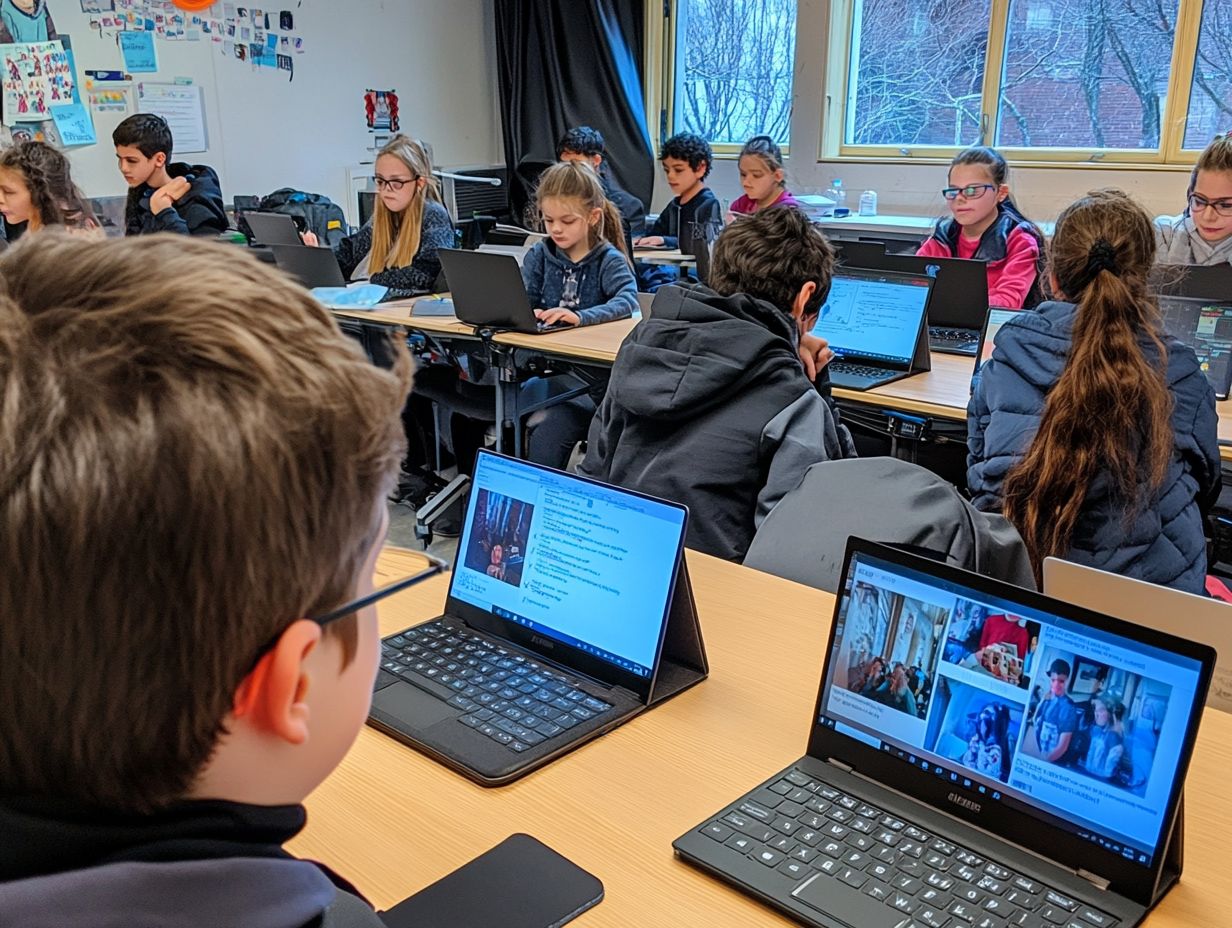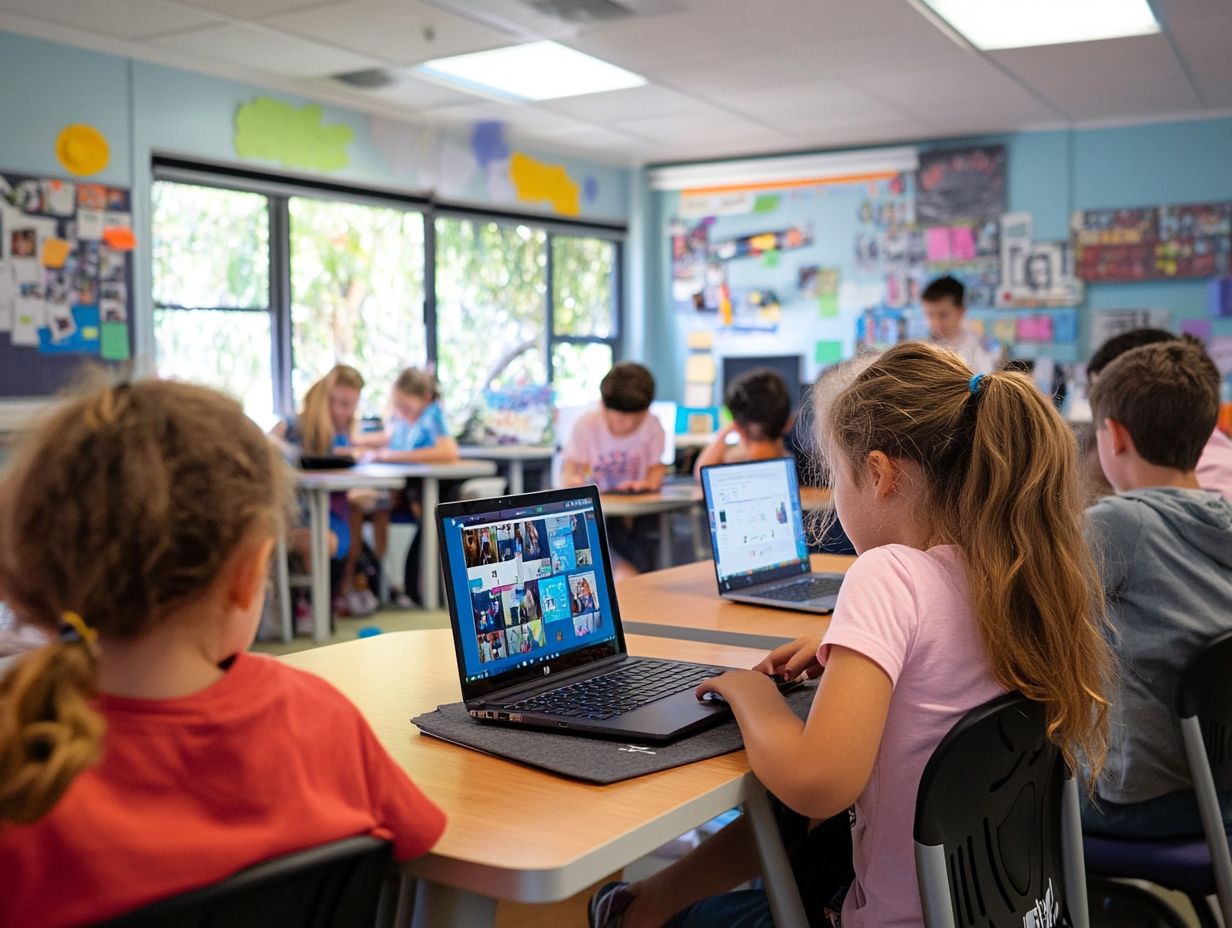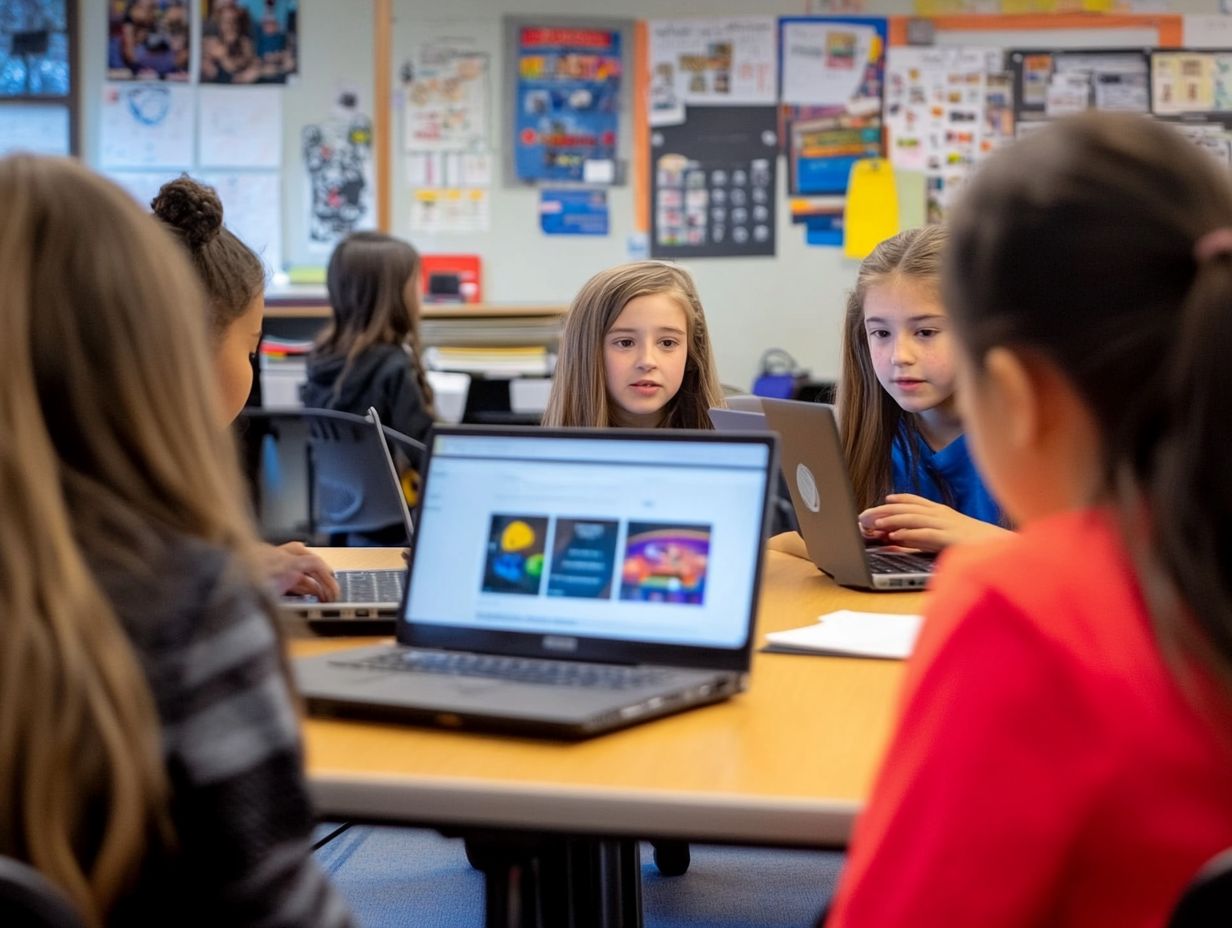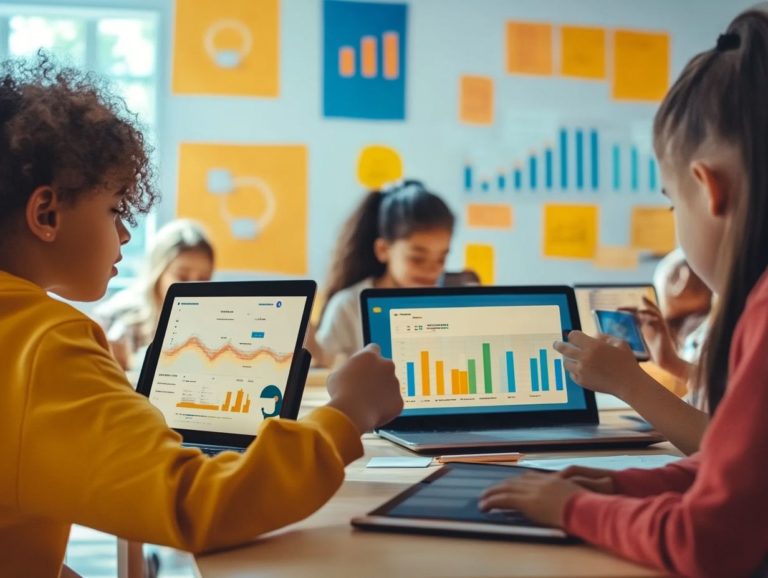The Benefits of Blended Learning Approaches
Blended learning is transforming education by combining traditional classroom instruction with online experiences.
This article explores what blended learning is, its key components, and the benefits it offers.
You will uncover effective strategies for implementing blended learning in classrooms, address common challenges educators encounter, and explore emerging trends poised to shape its future.
Discover how blended learning can elevate education for all stakeholders involved.
Contents
- Key takeaways:
- Understanding Blended Learning
- Benefits of Blended Learning
- Implementing Blended Learning in the Classroom
- Challenges and Solutions
- Future of Blended Learning
- Frequently Asked Questions
- What are the advantages of blended learning for educators?
- Can blended learning benefit students with different learning styles?
- Are there cost-saving benefits to implementing blended learning?
- How can blended learning help prepare students for the future workforce?
Key takeaways:

- Blended learning combines traditional and online methods for better results.
- It provides flexibility, allowing students to learn at their own pace, anytime and anywhere.
- Implementing this model can be cost-effective for schools.
Understanding Blended Learning
Blended learning is a modern approach that combines in-person teaching with online lessons.
This flexible model is designed to meet the diverse needs of a global audience.
By leveraging technology and digital tools, blended learning enhances your educational experience and improves outcomes.
It supports personalized learning, helping students learn in ways that suit them best.
With self-paced modules and virtual classrooms, blended environments empower both you and your instructors.
This fosters engagement and accessibility throughout your educational journey.
Benefits of Blended Learning
The benefits of blended learning are extensive, providing increased flexibility and engagement for students and instructors alike.
This innovative approach elevates your overall learning experience.
It allows for a customized instructional design that caters to the diverse needs of a global audience.
Blended learning promotes individualized learning through tailored technologies.
This ensures that your unique learning journey is both effective and enriching.
Improved Learning Outcomes
Blended learning significantly enhances your academic journey by utilizing learning analytics and data-driven strategies.
This boosts engagement and pinpoints areas for improvement.
It offers personalized feedback and targeted instruction, ensuring you receive the tailored support needed to thrive.
Many schools now integrate online platforms that provide real-time feedback.
These tools enable you to track your progress and adjust your study habits accordingly.
Instructors play a pivotal role; their guidance helps create a more interactive learning environment.
By analyzing your performance data, educators can craft customized lesson plans that align with your learning pace.
Success stories from institutions embracing blended learning show how combining in-person instruction with digital resources fosters deeper understanding and enhances retention rates.
Increased Flexibility and Accessibility

Blended learning offers remarkable flexibility and accessibility. You can engage with course materials at your own pace and from any location.
This flexibility accommodates various learning styles and fosters your autonomy, empowering you to take control of your educational journey.
Platforms like Canvas and Google Classroom have intuitive interfaces. They enable you to access lecture videos, join discussion forums, and submit assignments at your convenience.
Whether you re balancing work, family, or travel, you can shape your learning experience! Interactive tools such as quizzes and fun assessments make the educational process engaging and effective.
Blended learning adapts to your individual schedule and ensures that you have every opportunity to thrive in your educational pursuits.
Cost-Effectiveness
Blended learning offers a cost-effective solution for educational institutions. It allows you to reduce overall expenses associated with traditional instruction while maximizing the potential of digital tools and resources.
This model empowers you to implement effective teaching strategies that lower operational costs and broaden access to quality education.
Combining online and in-person learning saves resources and benefits students. You can minimize the need for physical materials, leading to savings on printing and distribution.
Distance education lets you reach a wider audience. This enables schools and universities to enroll students from diverse geographical areas, resulting in increased enrollment numbers and revenue.
Community colleges embracing blended learning report enhanced financial sustainability. They attract more students seeking flexible learning schedules.
This powerful combination transforms your learning journey and ensures that institutions remain financially viable in an increasingly competitive educational landscape.
Implementing Blended Learning in the Classroom
Implementing blended learning requires careful planning of effective lessons. It’s important to combine face-to-face instruction with online learning elements.
To achieve success, equip faculty with the skills and training needed to navigate this innovative landscape. This ensures a smooth transition to blended environments.
Strategies for Incorporating Blended Learning
To effectively incorporate blended learning into educational institutions, employ strategies that elevate the learning experience. Use collaborative tools and performance support systems.
These strategies boost engagement and ensure a seamless fusion of digital and face-to-face learning environments. One practical approach is to leverage digital platforms like Google Classroom or Microsoft Teams.
These tools enable you and your students to collaborate in real-time, share resources, and provide feedback effortlessly. This turns the classroom into a dynamic community of learning.
By offering professional development workshops, you equip instructors with essential skills for effective tool utilization. This fosters a culture of continuous improvement and adaptability.
Schools embracing these platforms often report significant increases in student participation. Learners feel more connected and motivated to engage.
Creating a supportive educational culture enhances academic achievement. It empowers students by incorporating their voices into the learning process, enriching the overall educational experience.
Challenges and Solutions

Blended learning offers a wealth of benefits. However, implementing it comes with its own set of challenges that your educational institution must navigate carefully to meet the needs of all learners.
You need to tackle these obstacles with a deep understanding of faculty competencies and a readiness to adapt your instructional strategies to accommodate a diverse student population.
Common Obstacles and How to Overcome Them
Common obstacles in implementing blended learning often include resistance from faculty, lack of training, and insufficient technological resources. Each poses a significant barrier to the successful adoption of this innovative educational model.
To navigate these challenges effectively, focused professional development and a commitment to instructional strategies that cater to the needs of both educators and students are essential.
Faculty resistance typically arises from apprehensions about technology or a steadfast belief that traditional teaching methods reign supreme. To counter this, institutions can foster collaborative workshops where educators exchange experiences and showcase their successes with blended learning.
Lack of training for both instructors and students can lead to a cycle of frustration. Establishing comprehensive onboarding programs coupled with ongoing mentorship can bridge this gap, ensuring that everyone feels empowered to make the most of digital tools.
Addressing insufficient technological resources is crucial. Forming partnerships with tech companies can yield discounted or even free access to essential tools, laying a robust foundation for a sustainable blended learning environment.
Future of Blended Learning
Get ready! The future of blended learning is about to transform education, propelled by emerging trends and advancements in digital education that are reshaping the educational landscape.
As technology continues to evolve, you will witness the rise of innovative learning environments designed to adapt seamlessly to the ever-changing needs of both students and instructors.
Trends and Potential Advancements
Current trends in blended learning highlight the importance of integrating advanced digital tools and innovative learning models. These set the stage for a more engaging and effective educational experience.
Such advancements give you the power to create dynamic and interactive learning environments that cater to the diverse needs and preferences of your learners.
With the growing presence of AI technologies, personalized learning paths are becoming increasingly attainable. This allows students to progress at their own pace while receiving tailored content that addresses their unique challenges.
Learning analytics emerges as another essential tool, providing useful information into student performance and engagement. This gives you the power to refine your teaching strategies and enhance the learning journey for your students.
Interactive learning tools, such as gamified content and virtual simulations, not only boost motivation but also deepen understanding by making complex concepts more tangible.
Together, these developments drive engagement and significantly enhance learning outcomes, transforming education into a more adaptive and impactful experience.
Frequently Asked Questions

What is blended learning and why is it beneficial?
Blended learning is an educational approach that combines in-person classes with online learning experiences. It offers a variety of benefits such as increased flexibility, personalized learning, and improved access to resources and materials.
How does blended learning promote student engagement?
Blended learning allows students to interact with content in different ways, such as through online videos, interactive activities, and group discussions. This variety keeps students engaged and motivated to learn.
Have you ever wondered how blended learning can change your education experience? Explore blended learning further and share your experiences!
What are the advantages of blended learning for educators?
Blended learning creates a dynamic and interactive classroom. Educators can easily track student progress and adjust their teaching, leading to better results.
Can blended learning benefit students with different learning styles?
Absolutely! Blended learning offers visual, auditory, and hands-on learning options. This variety helps students connect with the material in their own unique way.
Are there cost-saving benefits to implementing blended learning?
Indeed! Blended learning cuts costs by reducing the need for physical materials. It also saves money on commuting since students can learn from home.
How can blended learning help prepare students for the future workforce?
Blended learning equips students with essential skills for today’s job market. They learn to navigate technology and become self-directed learners, which employers highly value.






